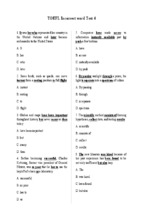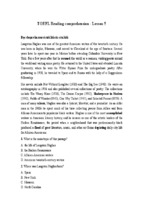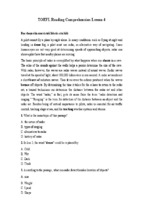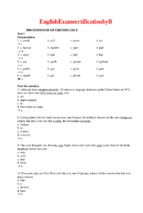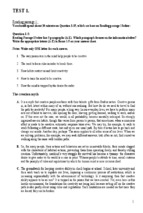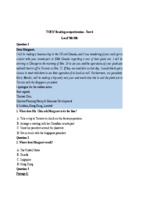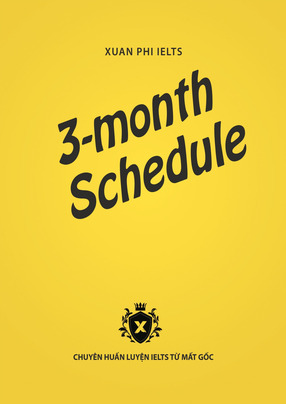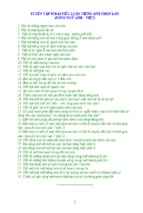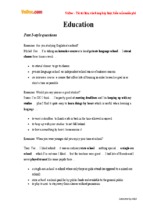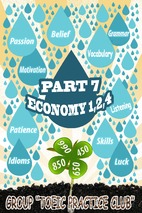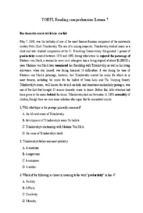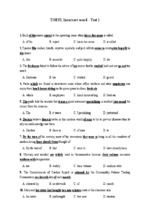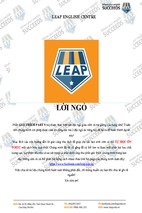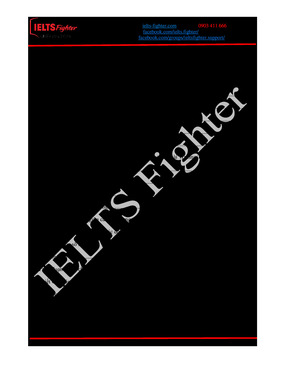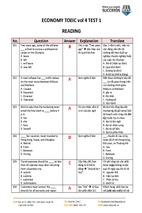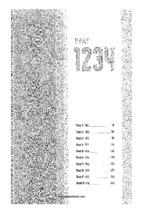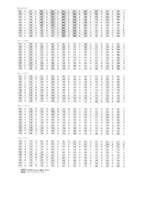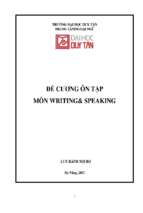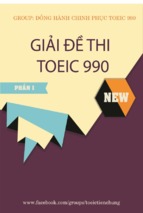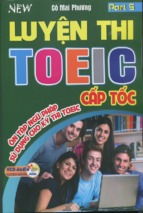Hp Group (www.hp-vietnam.com)
Đề thi TOEFL tháng 8 năm 2005
SECTION I
PART A
1.
(A) He is not sure where the student-service’ office is.
(B) He recently got a new student ID card.
(C) He is too busy to go to the student-services office now.
(D) He plans to get his new student ID card on Monday.
2.
(A) She lost the man's calculator.
(B) She will lend the man her calculator.
(C) The calculator may be under the man's book.
(D) The man will not have time to find the calculator.
3.
(A) He wanted to be an artist.
(B) He is not qualified to judge the painting.
(C) The painting is not finished yet.
(D) He will find a fine arts major for the woman.
4.
(A) She does not know where the student center is.
(B) She does not need a flu shot this year.
(C) Flu shots will not be free this year.
(D) She would like to get a free flu shot next week.
5.
(A) He will be studying tomorrow.
(B) He will see the game at night.
(C) He does riot like baseball.
(D) He has a ticket for the game.
6.
(A) She is not sure if she can attend the meeting.
(B) She will be out of town until Friday.
(C) She has been planning to go to the meeting.
(D) She cannot change her schedule for Friday.
7.
(A) He will help the woman move.
(B) The woman needs to accept her current situation.
(C) The woman can move in the middle of the semester.
1
Hp Group (www.hp-vietnam.com)
(D) The woman is already living in the best dorm.
8.
(A) She will help me man look for the book:.
(B) She knows where the man's book is.
(C) She will return the book to the man later.
(D) She saw someone walk away with the man's book.
9.
(A) Lend the woman money
(B) Get the woman's purse
(C) Invite the woman to lunch next week
(D) Pay for the woman's lunch
10.
(A) Ask the man to help her figure out how to' use her new computer
(B) Let the man use her computer
(C) Take her computer to a repair shop
(D) Help the man fix his Computer
11.
(A) He always exercises on Wednesdays.
(B) He would like to play tennis with the woman this week.
(C) He thinks the woman plays tennis as well as he does.
(D) He always plays tennis with the same person.
12.
(A) Professor Miller is not teaching in this semester.
(B) Professor Miller teaches anthropology. •
;
(C) The man should take a different biology course,
(D) The man is looking in the wrong part of the catalog.
13.
(A) He will do it before he begins his other work.
(B) He will submit it on Thursday.
(C) He has already finished it.
(D) He is allowed to complete it later.
14.
(A) She forgot about the sale books.
(B) She thinks the man should get a second job.
(C) She wants the man to move the sale books.
(D) She has changed her mind about the textbooks.
15.
2
Hp Group (www.hp-vietnam.com)
(A) She does not agree that it is a stressful time.
(B) She does not feel as calm as she seems.
(C) She admires the man's calmness.
(D) She will help the man to deal with his stress.
16.
(A) He would like to take a break.
(B) He thinks the library will close soon.
(C) He does not want to stop working.
(D) He does not like coffee.
17.
(A) When he is coming to visit
(B) Why he was not as friendly as
(C) Why he did not feel well
(D) What he was trying to tell her on the phone
18.
(A) Mary is not going to the
(B) Mary does not know about the concert.
(C) The man should call Mary.
(D) The man should go to the concert without Mary.
19.
(A) The woman was surprised by the topic of Professor Black's lecture.
(B) The man was out able to attend Professor Black' s lecture.
(C) Professor Black missed class today.
(D) Professor Black gives challenging lectures.
20.
(A) He does not have time to help the woman.
(B) He is not sure whether he can help the woman.
(C) He can help the woman after three o'clock.
(D) He will help the woman.
21.
(A) Become a photography instructor
(B) Return to her old photography class
(C) Try a class at the new studio
(D) Look for a less expensive class
22.
(A) It is hard to read.
(B) Some of the answers are wrong.
3
Hp Group (www.hp-vietnam.com)
(C) The professor requires that it be typed.
(D) It was not completed on time.
23.
(A) Continue working on her paper
(B) Go out for coffee
(C) Ask the man to bring her coffee
(D) Prepare a pot of coffee for the
24.
(A) Phone the company to ask about the job
(B) Buy a new answering machine
(C) Wait for the company to call him
(D) Assume that he did not get the job
25.
(A) Jim might not have been
(B) Jim often changes his mind,
(C) Jim was just joking about
(D) Jim rarely tells jokes.
26.
(A) It will take a few days for the fan to be repaired.
(B) Air conditioners will be installed on Saturday.
(C) Using the oven made the apartment hotter.
(D) The weather will cool off soon.
27.
(A) She is not sure how long it takes to knit a sweater.
(B) She will make a sweater for the man,
(C) The wool she uses for her sweaters has gotten very expensive.
(D) Her academic schedule does not allow time for knitting.
28.
(A) Tell the woman what time the bus will come
(B) Change his class schedule
(C) Go downtown with the
(D) Give the woman his history book
29.
(A) She plans to attend the meeting.
(B) She thinks the meeting time will be fine for everyone.
(C) She enjoys going to basketball games:
(D) She set up the study group meeting time.
4
Hp Group (www.hp-vietnam.com)
30.
(A) He read an article about Professor Monroe's research.
(B) He does not know Professor Monroe
(C) Professor Monroe probably will talk to the woman.
(D) Professor Monroe does not like giving interviews.
PART B
31.
(A) Inorganic chemistry
(B) Genetics
(C) Mathematics
(D) Anthropology
32.
(A) He is waiting to hear about the woman's research.
(B) He is more interested in DNA found in frogs.
(C) He is just twinning 10 gather the data.
(D) He avoids controversial research topics.
33.
(A) They attack and destroy other molecules.
(B) They do not reproduce under ordinary conditions.
(C) They do not contribute to the organism that supports them.
(D) They carry the blueprints only for complex organisms.
34.
(A) A swimming competition
(B) A singing contest
(C) The water temperature at the beach
(D) The woman's schedule this semester
35.
(A) They have won for the past three years.
(B) They placed second last year.
(C) They practiced for three months prior to the competition.
(D) She ihought they did not perform well.
36.
(A) Studying in the library
(B) Practicing his singing
(C) Walking on the iieach
(D)Swimming in the ocean
5
Hp Group (www.hp-vietnam.com)
37.
(A) She spent many hours on a bus.
(B) She was too busy to enjoy the beach.
(C) She had plenty of time to study.
(D) She did not have time to watch the competition.
38.
(A) Enter a singing competition
(B) Add new members
(C) Organize a graduation party
(D) Take a trip to the beach
PART C
39.
(A) Musicians of the early twentieth Century
(B) Early vaudeville theaters in Europe
(C) The development of American silent films
(D) The history of vaudeville entertainment
40.
(A) Their scripts were written by famous playwright*.
(B) They featured a variety of
(C) They did not include music.
(D) They were usually performed outdoors.
41.
(A) To acquaint audiences with a European art form
(B) To increase attendance at the vaudeville theaters
(C) To introduce new actors to the audience
(D) To enable vaudeville theaters to raise ticket prices
42.
(A) It was performed more frequently.
(B) It featured actors from films.
(C) It became less popular,
(D) It was first accepted as serious
43.
(A) One factor that affects the Earth's climate
(B) The professor's experience analyzing types of dust
(C) How to estimate temperature the ice ages
(D) The use of technological advances in studying climate
6
Hp Group (www.hp-vietnam.com)
44.
(A) To find ways of improving aircraft safety in storms
(B) To discover new species of bacteria
(C) To find out whether dust contains dangerous substances
(D) To determine what types of dust are present under different conditions
45.
(A) To explain why collecting dust is difficult
(B) To illustrate the damage that dust can cause
(C) To show how different types of dust affect the weather in different ways
(D) To give an example of how dust in the atmosphere is reduced
46.
(A) Whether dust caused the last ice age
(B) Whether the overall effect of dust is heating or cooling
(C) How high temperatures affect the amount of dust in the
(D) How cold the planet was daring the lie ages
47.
(A) Reasons the Mycenaeans never became successful sea traders
(B) The development and decline of Minoan and Mycenaean sea trade
(C) The influence of the Mycenaeans on the Minoans
(D) Causes of conflict between the Minoans and Mycenaeans
48.
(A)They existed long before the Minoans began to trade by sea.
(B) They produced great wealth for the Minoans.
(C) They were established by the Mycenaeans.
(D) They were frequently attacked by the Mycenaeans.
49.
(A) It ended the dominance of the Minoans.
(B) It resulted in increased sales of farm goods by [he Minoans.
(C) It was not serious enough to affect Sea trade.
(D) It interrupted the Mycenaean production of bronze objects.
50.
(A) The decline of their harbors
(B) Natural disasters that destroyed their crops
(C) An increase in trade by the Minoans
(D) Politician unrest that interfered with trade.
7
Hp Group (www.hp-vietnam.com)
SECTION II
PART A
1. Drinking water-------excessive enamel of teeth to become brittle and to chip off, leaving a
stained or mottled effect.
(A) containing
(B) in which containing
(C) contains
(D) that is contained
2. Carbohydrates, -------of the three principal constituents of food, form the bulk of the average
human diet
(A) are one
(B) one [hat
(C) one
(D) which one
3. -------the eye, a camera takes in rays of light thai are reflected from an object and focuses the
rays into an image.
(A) Alike
(B) As like
(C) Is like
(D) Like
4. Great pain and swelling characterize both sprains and fractures, but------- he affected part and
unnatural ting often indicate a bone break. inability lo move
(A) inability to move
(B) they were unable to move
(C) unable to move
(D) when inability to move
5. The human skin forms-------against the action of physical, chemical, and bacterial agents on the
deeper tissues.
(A) a protective barrier is
(B) a protective barrier
(C) a barrier and protective
(D) when a protective barrier
6. The technique of frying food has prepare n^eats, fish, vegetables, and breads.
(A) to have most cultures
(B) that in most cultures
(C) in cultures when
(D) in most cultures
8
Hp Group (www.hp-vietnam.com)
7. Music has been called both the most mathematical-------the most abstract of the arts.
(A) but
(B) and
(C) however
(D) or
8. Roots of plants lend to grow downward into soil, unless —-— more readily available at the
surface.
(A) have water
(B) water has
(C) is water
(D) water is
9. United States income taxes are paid to the Internal Revenue Service,-------funds for use by the
government.
(A) which distributes
(B) and distributes
(C) the distribution of
(D) so that the distribution of
10. Robert Penn Warren's first novel was published in 1939, and seven years later, his third novel,
All the King's Men, made —-— famous.
(A) he was
(B) him
(C) his
(D) how he was
11. Although legend has it that the Pilgrims first set foot in America on Plymouth Rock in 1620,
------- documentary evidence confirming
(A) no
(B) still is no
(C) there is no
(D) but no
12. The gardenia, about 200 species --—to tropical and subtropical countries, was named in honor
of eighteenth-century naturalist Alexander Garden.
(A) native of which are
(B) are nalive of which
(C) which are native of
(D) of which are native
13- High-speed photography has made -------certain aspects of motion never before seen.
(A) visible
9
Hp Group (www.hp-vietnam.com)
(B) they are visible
(C) visibly
(D) it visible
14. Nitroglycerin is an unstable chemical compound that is very sensitive sudden movement
-------dangerous to transport
(A) because
(B) and therefore
(C) why it is
(D) making
15. A computer is a fast electronic machine ------- information according to a stored sequence of
instructions called a program.
(A) processes
(B) that processes
(C) that it processes
(D) thai processes it
PART B
16. Lucy Motile Montgomery, a Canadian novelist, is best of known for Anne of Green Gables,
the story of a spirited, unconventional orphan girl.
17. Every magnet has two ends, called north and south poles, where the forces it exert are
strongest
18. Approximate 92 percent of the world's trading goods are transported by ships.
19. Rapid eye movement sleep is sometimes called paradoxical sleep because it has
characteristics of either the waking and sleeping states.
20. With the exception of gold, silver is most malleable and ductile of all metals.
21. The fact that mothers in some species of animals reaction immediately if they are missing one
or more of their litter demonstrates a sense of number.
22. Approximately four percent of human body weigh is made up of fat in me organs, skeletal
muscles, and central nervous system.
23. By about seven years of age, children begin to grasp that a given quantity remains the same
not matter how its shape changes.
24. Sleek and powerful swimmers found to all seas, dolphins are distinguished from porpoises by
well-defined, beaklike snouts and conical teeth.
10
Hp Group (www.hp-vietnam.com)
25. Stereo recording began with the introductory of two-track magnetic tape in the 1950s
26. The cerebral cortex, the outer layer of the brain, is where most memory storage, cognitive
skills, and creative think reside.
27. The physical universe is governed by law that demand the continuous increase of entropy or
disorder.
28. Metonymy is a literary device involving the substitution of the name of one thing with that of
other thing with which it is closely associated.
29. The 1906 Hepburn Act gave the United Stales Interstate Commerce Commission power to
investigated financial accounts of interstate utilities and to set rates, subject to judicial review.
30. Although Republican Dwight Eisenhower won the United Slates presidency in 1952 and 1956,
the Democrats ran Congress for six of his eight years into office.
31. Substance such common salt, when dissolved in water, lower the freezing point of water
32. Some advantages of celluloid ate that it is inexpensive and durable, takes a highly polish, does
not warp or discolor, and is not affected by moisture •
33. The pitch of a musical note—how much high or low the sound is depends on its wavelength.
34. Two good ways to prevent attacks of hay fever are to effect a change of climate also to
eliminate harmful substances from the environment.
35. In filmmaking a flashback is an interruption of the actual chronology of a story to relate a
significant event of a earlier time.
36. The bottom end of a guitar string is attached to a hardwood bridge, which transmitting the
vibration to the top plate.
37. Missouri is a heavily industrialized state whose leading products are transportation equipment,
processed food, and chemical.
38. Seamounts are isolated submarine mountains believed to be the remnants of extinct volcanoes
that either formed or sank far beneath of the ocean surface.
39. Transfusion of plasma or whole blood increases the volume of circulating blood, raising
blood pressure and ensuring adequate distribution of oxygenated blood among the body.
40. The national debt is the sum total of financial obligations the national government incurs by
11
Hp Group (www.hp-vietnam.com)
borrow from foreign governments, international institutions, or its own population.
SECTION III
Questions 1-10
Unlike those available for painting, the opportunities to exhibit sculpture in the
United-States around the turn of the twentieth century were quite scarce. There was
almost no room for sculpture at the influential Fine Arts Society's 57th Street Galleries
Line
in New York. As late as 1905, the Monumental News, a journal dedicated to the
5
promotion of sculpture, lamented, "Exhibitions of sculptors' works are so comparatively
rare." In response to this dire predicament, (he sculptor Frederick W. Ruckstull and
Charles de Kay, art editor of the newspaper The New York Times, founded the National
Sculpture Society (NSS) in 1893, the first organization dedicated solely to the
advancement of sculpture.
10
Incorporated in 1896 to promote sculptural production and encourage the exhibition
and sale of the plastic arts, the National Sculpture Society (NSS) elected John Quincy
15
20
25
Adams Ward (1830-1910), the prestigious sculptor of public monuments, to serve as its
first president, an office he held from 1893 to 1905. During the last twenty years of his
life, ward dedicated much time to public and private organizations that promoted public
art. To the end, he headed the NSS committee that oversaw the sculptural decoration of the
Library of Congress Reading Room in Washington D.C. as well as the building and
decorating of the Dewey Arch—a monument in New York to honor Admiral George
Dewey. He was a champion of the City Beautiful Movement— an effort to increase the
presence of urban art—and defended the central role that sculpture played in its national
program.
The National Sculpture Society promoted the production of sculpture by standardizing
procedures for competitions, enhancing the professional status of sculptors, and
encouraging commissions for American sculpture in homes, public buildings, parks,
and squares. Moreover, ii included members in its organization who were not sculptors,
hoping to close the gap between artists and the great body of the people, not merely
well-to-do patrons, bui the working public. The NSS encouraged the commission and
purchase of sculptures for both private consumption—home and garden—and for public
enjoyment—parks and squares. Through this campaign, small-scale sculptures—either
reductions of monumental artworks or smaller-sized originals—were brought to the
attention of an interested public.
1. What does the passage mainly discuss
(A) The establishment and goals of the National Sculpture Society
(B) Why artists of the twentieth century wanted to jojn the National Sculpture Society
(C) The effects of the National Sculpture Society on twentieth-century art
(D) The relationship between the National Sculpture Society and national arts groups
2. The word "scarce" in line 2 is closest in meaning to
(A) exciting
(B) expensive
12
Hp Group (www.hp-vietnam.com)
(C) uncommon
(D) popular
3. The word "lamented" in line 5 is closest in meaning to
(A) declared
(B) complained
(C) revealed
(D) described
4. What is (he "dire predicament" mentioned by the author in line 6 ?
(A) The limited professional opportunities for sculptors
(B) The failure of the Fine Arts Society to include paintings in its exhibitions
(C) The founding of the National Sculpture Society
(D) The production of the Monumental News
5. The passage suggests which of the following about early-twentielh-century art?
(A) Many New Yorkers were not interested in painting.
(B) Newspapers and journals rarely discussed painting.
(C) People saw more public displays of painting than of sculpture.
(D) An appearance in galleries of the Fine Arts Society guaranteed financial success.
6. According to the passage, who was the first president of the National Sculpture Society?
(A) Frederick W. Rucksmll
(B) John Quincy Adams Ward
(C) Charles de Kay
(D) Admire! George Dewey
7. The phrase "that end" in line 15 refers to
(A) the last twenty years of his life.
(B) much time
(C) promoting public art
(D) the NSS committee
8. The word "champion" in line 18 is closest in meaning to
(A) critic
(B) founder
(C) creator
(D) supporter
9. According to the passage, what was a goal of the City Beautiful Movement?
(A) To increase national sales of Sculpture
(B) To encourage sculptors to create more monuments
(C) To improve to appearance of the city with art
(D) To convince more sculptors to work in New York
13
Hp Group (www.hp-vietnam.com)
10. According to the passage, the National Sculpture Society promoted the production of
sculpture by doing which of the following?
(A) Carrying oui activities that increased the public's respect for sculptors
(B) Replacing old sculptures in public places with new ones
(C) Increasing the number of sculptural competitions
(D) Encouraging private sculpture lessons in homes
Questions 11-20
In the United States, many social reformers in the late nineteenth century demonstrated
a concern for improved housing conditions for workers, George Pullman (1831-1897),
the wealthy industrialist who introduced luxury railway cars with beds, built his model
tine city called Pullman in 1880 to address housing problems caused by Chicago's
5
industrialization. Constructing the town, Pullman hoped to produce an ideal environment
that would help attract workers of a superior type to [he railway car industry and retain
10
15
20
25
them. Pullman inhabitants were expected to embody values of thrift, industry, and
morality. They were taught to develop propriety and good manners, cleanliness and
neatness of appearance, diligence, and self-improvement through education and savings.
Like the brick clock tower that dominated [he town center, Pullman kept a regulatory eye
on his workers.
In its first five yean, this new experiment in industrial life received little criticism,
except from radical political groups. Crediting the town of Pullman with producing a new
type of dependable and ambitious worker in a rationally ordered environment, reformers,
at first, praised it as a successful model for modern industrial life. However, after 1885,
with the high gloss of the experiment dulled, it became clear that the residents of Pullman
had honest grievances about the overcharging of rent and other services.
In 1893, The World's Columbian Exposition, an exhibition that aimed to promote
American cultural, economical, and technological development, and in which George
Pullman was a major investor, was held in Chicago. The town of Pullman became a
popular tourist stop, attracting more than its share of curious travelers. There were 10,000
foreign viators-alone during the exposition year. In fact, the first Baedeker Travel Guide
to the United States advised visitors to tour Pullman. Frequent trains and trolley cars
connected the fairgrounds of the exposition with the town, and on several occasions,
George Pullman himself guided the tours. Constructing a fantastic environment for the
benefit of tourists, he made sure that any real tensions between bis office and the working
inhabitants of the town were rendered invisible to the tourist gaze.
11. What does the passage mainly discuss?
(A) The effect of industrialization on Ihe city of Pullman
(B) The model city built by George Pullman
(C) The career of George Pullman
(D) Housing problems in the nineteenth century '
12. According to the passage, which L the following led to the creation of the town of
14
Hp Group (www.hp-vietnam.com)
Pullman?
(A) A surplus of railway workers in Chicago
(B) Housing problems caused by industrialization
(C) George Pullman's decision to slop producing railway cars
(D) The opening of the World's Columbian Exposition
14. According to the passage, George Pullman expected that the city of Pullman would
(A) impress social reformers
(B) satisfy radical political groups
(C) soon develop housing problems
(D) draw workers Co the railway car industry
15. According to the passage. Pullman inhabitants were taught to do all of Ihe following
EXCEPT
(A) have good manners
(E) become active in town politics
(C) value education
(D) save money
13. The word "retain" in line 6 is closest in meaning to
(A) house
(B) train
(C) keep
(D)reward
16. What does the author imply about George Pullman's attitude toward his workers in
lines 10-11 ?
(A) Pullman believed that his workers should follow a strict daily schedule.
(B) Pullman felt that his workers required careful monitoring and supervision.
(C) Pullman thought that individual workers could be taught to work together as a team.
(D) Pullman believed that his workers had trouble keeping track of the time they spent on
a task.
17. The word "grievances" in line 17 is closest in meaning to
(A) stories
(B) opinions
(C) findings
(D) complaints
18. The passage suggests that George Pullman worked to hide which of the following
from tourists?
(A) His role as an investor in the World's Columbian Exposition
(B) His conflicts with the inhabitants of the town of Pullman
(C) His efforts to promote the town of Pullman
15
Hp Group (www.hp-vietnam.com)
(D) His lack Of knowledge about how the Inhabitants of Pullman really lived
19. According to the passage, what did George Pullman do to promote tourism in the
town of Pullman?
(A) He personally showed tourists around the town.
(B) He published a travel guide to the town.
(C) He started to invest in the town's cultural development.
(D) He built a new road connecting it to the World's Columbian Exposition.
20. Why does the author mention the first Baedeker Travel Guide to the United States?
(A) To explain where tourists could find train and trolley schedules
(B) To identify a way used by George Pullman to attract tourists to Pullman
(C) To indicate how a large number of foreign tourists became interested in visiting the
town of Pullman
(D) To provide evidence that tourists were often more interested in visiting Pullman than
in seeing the World's Columbian Exposition
Questions 21-29
Face masks are commonly used in rituals and performances. They not only hide
the real face of the mask wearer but they often evoke powerful emotions in the
audience-danger, fear, sadness, joy. You might think, because so many things vary
Line
cross-culturally, that the ways in which emotions are displayed and recognized in the
5
face vary too. Apparently they do not. Recent research on masks from different cultures
supports the conclusion that masks, like faces, tend to represent certain emotions in the
some ways. We now have some evidence that the symbolism used in masks is often
universal
10
15
20
25
The research on masks builds on work done by anthropologists, who used photographs
of individuals experiencing various emotions. These photographs were shown to members
of different cultural groups who were asked to identify the emotions displayed in the
photographs. Emotions were identified correctly by most viewers, whatever the viewer's
native culture.
Coding schemes were developed to enable researchers to compare the detailed facial
positions of individual portions of die face (eyebrows, mouth, etc.) for different emotions,
What exactly do we do when we scowl? We contract the eyebrows and lower the comers
of the mouth; in geometric terms, we make angles and diagonals on our faces. When we
smile, we raise the corners of the mouth; we make it curved.
Psychologist Joel Arnoff and his colleagues compared two types of wooden face masks
from many different societies—masks described as threatening versus masks associated
with nonthreatening functions. As suspected, the two sets of masks had significant
differences in certain facial elements. The threatening masks had eyebrows and eyes
facing inward and downward and a downward-facing mouth. In more abstract or
geometrical terms, threatening features generally tend to be angular or diagonal and
nonthrcatening features tend to be curved or rounded, A face with a pointed beard is
threatening; a baby's face is not. The theory is that humans express and recognize basic
emotions in uniform ways because all human faces are quite similar, skeletally and
16
Hp Group (www.hp-vietnam.com)
muscularly.
21. What does the passage mainly discuss?
(A) The techniques for comparing facial expressions across cultures
(B) The photography of faces
(C) Cultural variations in mask
(D) The uniformity of facial expressions in revealing emotions
22. According to the passage, masks are used in performances to
(A) disguise the real emotions of the performers
(B) cause members of the audience to have strong emotional
(C) remind the audience that an illusion is being created
(D) identify the cultural background of the performers
23. The word "they" in line 2 refers to
(A) masks
(B) rituals
(C) performances
(D) emotions
24. The word "evidence" in line 7 is closest in meaning to
(A) concern
(B) interest
(C) roof
(D) reference
25. What does the author mean by stating, "the symbolism used in masks is often universal" (lines
7-8)?
(A) Masks are sometimes used to hide emotions.
(B) Performers often need help conveying emotions to an audience.
(C) Not all societies use masks in their rituals and
(D) People from different cultures generally express certain emotions in similar ways.
26. The word "schemes" in line 14 is closest in meaning to
(A) systems
(B) presentations
(C) proposals
(D) investigations
27. What does the author suggest by Stating, "in geometric terms, we make angles and diagonals
on our faces" (line 17)?
(A) Different portions of the face are used to show specific emotions.
(B) It is difficult to use objective terminology to describe facial expressions.
(C) Facial expressions can be described in terms of shapes.
(D) Precise methods of classifying emotions have not been developed.
17
Hp Group (www.hp-vietnam.com)
28. The wood "significant" in line 21 is closest in meaning to
(A) excellent
(B) important
(C) continuous
(D) genuine
29. The passage mentions-"* baby's face" in line 26 as an example ofa
(A) typical human face
(B) source of inspiration in the creation of masks
(C) nonthreatening face
(D) face that expresses few emotions
Questions 30-39
Line
5
10
15
20
25
The response of most animals when suddenly faced with a predator is to flee. Natural
selection has acted in a variety of ways in different species to enhance the efficacy of the
behaviors, known as "flight behaviors" or escape behaviors that are used by prey in
fleeing predators: Perhaps the most direct adaptation is enhanced flight speed and agility.
Adaptations for speed. However, are likely to require sacrifices biter attributes, so we
might expect only some species to adopt a simple fast flight strategy. Another way of
enhancing the effectiveness of flight is to move in an erratic and unpredictable way. Many
species, like ptarmigans, snipes, and various antelopes and gazelles, flee from predators
in a characteristic zigzag fashion. Rapid unexpected changes in flight direction make it
difficult for a predator to track prey. In some species, like the European hare, erratic
zigzag flight might be more effective in the presence of predators that aie faster than they
are and straight flight more effective against predators that are slower. One observation
lhat supports this suggestion is the recorded tendency for slow-flying black-headed gulls,
which are normally able to escape predators by means of direct flight, to show frequent
changes in flight direction when they spot a peregrine falcon (peregrines are adept at
capturing flying birds).
A quite different way of enhancing escape by flight is to USB so-called "flash"
behavior. Here, the alarmed prey flees for a short distance and then "freezes." Some
predators are unexcited by immobile prey, and a startling flash of activity followed
by immobility may confuse them. "Flash" behavior is used in particular by frogs and
orthopteran insects, which make conspicuous jumps and then sit immobile. In some
species, "flash" behavior is enhanced by the display of bright body markings. Good
examples of insects with colorful markings are the red and yellow underwing moths.
At rest, both species are a cryptic brown color. When they fly, however, brightly colored
hind wings are exposed, which render the moths highly conspicuous. Similarly, some
frogs and lizards have brightly colored patches or frills that may serve a 'flash" function
when they move quickly, Some species even appear to possess "flash" sounds. The loud
buzzing and clicking noises made by some grasshoppers when they jump may serve to
emphasize the movement.
18
Hp Group (www.hp-vietnam.com)
30. The word "enhance" in line2 is closest in meaning to
(A) encourage
(B) resist
(C) increase
(D) reveal
31. The description of the prey's movement as "zigzag" in line 9 suggests that the
movement is
(A) reliable
(B) fast
(C) constant
(D) unpredictable
32. It can be inferred from the passage that the European hare
(A) is faster than most of its predators
(B) is capable of two kinds of flight
(C) is more likely to escape using straight flight
(D) is preyed upon by gulls and falcons
33. The behavior of black-beaded gulls is most comparable to that of
(A) gazelles
(B) European hares
(C) peregrine falcons
(D) frogs
34. It can be inferred that black-headed gulls change direction when they spot a
peregrine falcon for which of the following reasons?
(A) The falcons are faster than the gulls.
(B) The gulls want to capture the falcons.
(C) The falcons are unpredictable.
(D) The gulls depend on the falcons for protection.
35. The word "alarmed" in line 18 is closest in meaning to
(A) moving
(B) selected
(C) frightened
(D) exhausted
36. All of the following are mentioned as characteristics of "flash" behavior EXCEPT
(A) brief conspicuous activity
(B) Immobility
(C) bright body markings
(D) aggressive fighting
19
Hp Group (www.hp-vietnam.com)
37. The phrase "in particular" in line 20 is closest in meaning to
(A) especially
(B) with difficulty
(C) expertly
(D) frequently
38. The hind wings of red and yellow underwing moths function in a way that is most
similar to
(A) the hind wings of peregrine falcons
(B) the zigzag flight of European hares
(C) the colored patches on frogs
(D) the clicking of grasshoppers
39. Why does the author mention grasshopper* in line 28?
(A) To contrast animals that "flash" with animals that “freeze”
(B) As an example of an animal whose "flash" behavior is a sound?
(C) To compare the jumping behavior of insects and reptiles
(D) As an example of a predator that moths escape by using "flash" behavior
Line
5
10
IS
20
Questions 40-50
In the nineteenth century, oceanography benefited from the new desire to study
phenomena on a global scale. Many scientists collected information on the chemical
composition, temperature, and pressure of the ocean at various depths and in different
regions. The difficulty of gathering information about the ocean depths was immense.
At first ii was believed that the temperatures in the depths never fell below 4 degrees
Celsius, until it was shown that the figures were distorted by the effect of pressures on
the thermometers. There was intensive study of tides and ocean currents; and a number
of physicists examined the forces responsible for the movements of the water. For
example, James Reonell provided the first accurate map of the currents in the Atlantic.
Ocean, and the United Slates Coast Survey made extensive studies of the Gulf Stream.
The zoologist Edward Forbes argued that no lire existed below a depth of 300 fathoms
(about 600 meters) a view widely accepted until disproved by the voyage of the British
research vessel HMS Challenger(1872-1876)The HMS Challenger expedition provided
valuable information about the seabed, including the discovery of manganese nodules
that are now being seen as a potentially valuable source of minerals.
The first detailed map of the seabed was provided for the Atlantic by the American
geographer Matthew F. Maury- He devised new techniques for measuring ocean depths,
and his work proved of great value in laying the first transatlantic telegraph cables.
He also studied global wind patterns and was able to provide sailors with guides that
significantly reduced die time taken on many routes. Some oceanographers believed
that the winds were responsible for producing ocean currents such as the Gulf Stream,
but Maury disagreed. He argued that they were produced by changes in the density of
seawater due to temperature, which Bet up systems of movement between warm and
20
- Xem thêm -

